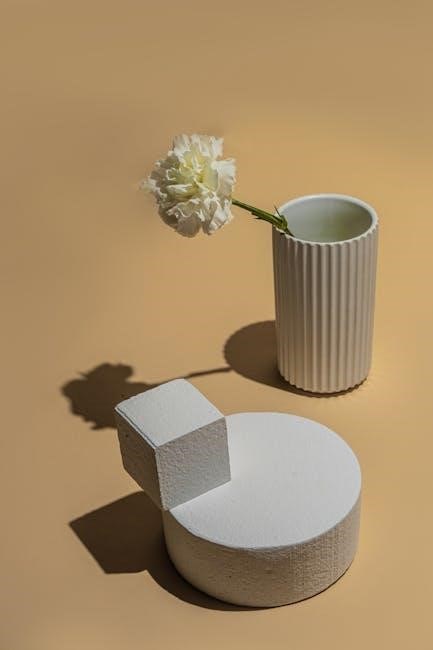Learning volume of composite figures begins with understanding shapes, using
basic math concepts
to calculate volumes of simple and complex figures, including prisms and solid shapes․
Understanding Composite Figures
To understand composite figures, students need to learn about different shapes, such as rectangular prisms, and how to calculate their volumes․
Using a volume of composite figures worksheet with answers pdf can help students grasp this concept․
The worksheets provide a variety of problems, including word problems, to help students understand how to find the volume of composite figures․
By breaking down complex figures into simpler shapes, students can calculate the total volume․
This skill is essential for real-life applications, such as architecture and engineering․
The worksheets are designed to gradually increase in difficulty, allowing students to build their confidence and understanding of composite figures․
With practice and patience, students can master the concept of volume of composite figures and apply it to various problems․
The worksheets are available in pdf format, making it easy for students to access and print them․
Importance of Volume of Composite Figures Worksheet
Volume of composite figures worksheets are essential for math skills development, particularly for 8th grade students, using online resources and pdf materials effectively every day․
Benefits for 8th Grade and High School Students
Volume of composite figures worksheets offer numerous benefits for 8th grade and high school students, including improved math skills and problem-solving abilities․
Using online resources and pdf materials, students can practice and reinforce their understanding of composite figures,
including rectangular prisms and solid shapes, with worksheets providing a comprehensive and structured approach to learning․
These worksheets cater to different learning styles and abilities, allowing students to work at their own pace and build confidence in their math skills․
With access to answers and solutions, students can assess their progress and identify areas for improvement,
developing a deeper understanding of volume and composite figures, and preparing themselves for more advanced math concepts․
Regular practice with volume of composite figures worksheets can lead to significant improvements in math performance and overall academic achievement․

How to Solve Volume of Composite Figures Problems
Solving problems involves breaking down composite figures into simpler shapes and calculating volumes using
basic formulas
and math concepts accurately always․
Step-by-Step Guide to Finding Volume
To find the volume of composite figures, start by identifying the individual shapes that make up the figure, such as rectangular prisms or solid shapes․ Next, calculate the volume of each shape using the relevant formulas, such as length times width times height for rectangular prisms․ Then, add the volumes of each shape together to find the total volume of the composite figure․ It is also important to consider the units of measurement and ensure that they are consistent throughout the calculation․ By following these steps and using the relevant formulas, students can develop a strong understanding of how to find the volume of composite figures and apply this knowledge to solve a variety of problems․ This guide provides a clear and structured approach to finding volume․

Types of Composite Figures
Composite figures include rectangular prisms and solid shapes combined together in various ways to form complex figures and shapes with different volumes and dimensions always․
Rectangular Prisms and Solid Shapes
Rectangular prisms and solid shapes are fundamental components of composite figures, used to calculate volumes and dimensions․
These shapes can be combined in various ways to form complex figures, with each component having its own volume and dimensions․
The volume of each component is calculated separately, using formulas such as length times width times height for rectangular prisms․
Solid shapes, such as cubes and cylinders, also have their own volume formulas, which must be applied correctly to find the total volume of the composite figure․
By breaking down complex figures into their component shapes, students can develop a deeper understanding of volume and dimension calculations, and improve their problem-solving skills․
This approach is essential for mastering the concept of volume of composite figures, and is a key aspect of mathematics education․
It is used in real-life applications, such as architecture and engineering․

Volume of Composite Figures Worksheet with Answers
Downloadable worksheets provide answers and solutions for calculating volumes of composite figures accurately online․
PDF Format and Increasing Difficulty
The volume of composite figures worksheet with answers is available in PDF format, making it easily accessible and printable․ The worksheets are designed to gradually increase in difficulty, allowing students to build their understanding and confidence in calculating volumes of composite figures․ The PDF format enables students to download and print the worksheets as needed, and the increasing difficulty level helps to challenge students and prepare them for more complex problems․ The worksheets include a variety of problems, from simple to complex, and provide detailed solutions and answers to help students understand the concepts․ By using these worksheets, students can develop their problem-solving skills and improve their understanding of volume calculations․ The PDF format is convenient and user-friendly, making it an ideal resource for students and teachers alike․

Practicing with Free Printable and Online Worksheets
Students can practice with free printable and online worksheets featuring various composite figures and volume problems to solve․
Building Confidence in Solving Complex Volume Problems
Using volume of composite figures worksheets with answers in PDF format can help students build confidence in solving complex volume problems․ By practicing with a variety of problems, students can develop their critical thinking skills and learn to break down complex shapes into simpler components․ The worksheets provide a step-by-step approach to solving volume problems, allowing students to understand the concepts and apply them to real-world scenarios․ As students work through the problems, they can check their answers and receive feedback, helping to reinforce their understanding and build confidence in their ability to solve complex volume problems․ With consistent practice, students can develop a deep understanding of volume and its applications, preparing them for success in math and science․ The worksheets are a valuable resource for teachers and students alike․
Real-Life Applications of Volume of Composite Figures
Volume of composite figures is used in architecture and engineering to design buildings and structures with complex shapes and volumes every day naturally․
Word Problems and Compound Shapes
Word problems involving volume of composite figures require students to apply mathematical concepts to real-life scenarios, such as calculating the volume of a building or a container․
These problems often involve compound shapes, which are composed of two or more simple shapes, and require students to break down the shape into its components and calculate the volume of each part․
The internet provides a wealth of resources, including worksheets and practice problems, to help students develop their skills in solving word problems involving volume of composite figures․
By practicing with these types of problems, students can improve their ability to think critically and apply mathematical concepts to a variety of situations․
This helps to build their confidence and fluency in math, and prepares them for more advanced math concepts․
Students can find many resources online to help them learn and practice․
